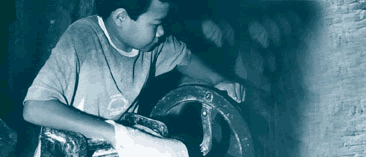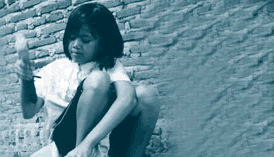 |
 |
||||||
 |
|||||||
| english | bahasa indonesia | home | TBP | pipe-line programmes | ||
|
|
Preparing
the foundations for a Time-Bound Programme for Indonesia Summary of the present situation IPEC has been active in Indonesia since 1992 with more than a hundred action programmes to combat child labour in the country. In general, most programmes were limited in scale and therefore their impact was also limited. Most important is that we draw lessons from the past and try to combat this very complex problem in society. After 10 years of experience, and with the ratification of both Convention 138 and Convention 182, the ILO wishes to encourage the government to combat this problem in a larger, more comprehensive way. The ILO will support Indonesia with technical assistance. With the ratification of ILO Convention 182 in March 2000, Indonesia committed itself to "take immediate and effective measures to secure prohibition and elimination of the worst forms of child labour as a matter of urgency". To demonstrate that the worst forms of child labour can be eliminated within a specific time-frame, ILO's International Programme on the Elimination of Child Labour (IPEC) has designed a new, integrated national "Time-Bound Programme (TBP)" approach, drawn from its own extensive experience and that of its many partner organizations worldwide. This approach is explained in the manual "Eliminating the worst forms of child labour: an integrated and time-bound approach; a guide for governments, employers, workers, donors and other stakeholders". Three countries are currently implementing such a programme: Nepal, Tanzania and El Salvador. A TBP is essentially a set of tightly integrated and coordinated policies and programmes to prevent and eliminate a country's worst forms of child labour within a certain period of time (5 to 10 years). This time-frame depends on the availability of resources, the nature of the worst forms of child labour, level of local expertise and other circumstances in each programme country. Eliminating child labour's worst forms requires a strong national commitment to implement a series of complementary policy measures designed to withdraw and rehabilitate working children and prevent at-risk children from becoming child labourers. It needs extensive preparation to ensure the programme is well targeted and effective. The time-bound approach also needs the involvement of all key stakeholders, including government at all levels, NGOs and workers' and employers' organizations. The TBP can be divided in four phases:
The time-bound programme is to be implemented by national organizations. Therefore, it is important to assess what their capacity is to design, monitor and evaluate the TBP and what needs to be done to improve it. There are reservations as to whether the partner organizations have the structures, policies or funds to support effectively a range of activities to combat child labour. There have been encouraging signs with the interest shown by the new Minister of Manpower and Transmigration and the progress made with the development of a National Plan of Action. Workers' and employers' organizations are still quite weak in general. Most workers' organizations are recently established and child labour is not a priority concern for them. The employers' organization represents mainly large enterprises, while most exploitative labour is happening in smaller and medium sized enterprises. NGOs may be the strongest partner, although very few specialize in child labour. Most capacity building efforts have been concentrating at NGOs. Many NGOs are very dependent on donor funding and as a result the activities cease to exist after the end of the project. JARAK, the network of NGOs on child labour issues, has potential to lead a movement against child labour, but at present is not that strong yet. Another problem is the scarce availability of academics and researchers, who can support development of child labour programmes. Partners could strengthen each other if they work together, but generally cooperation, and even coordination between all the partners, is still lacking. The process of a TBP will continue building capacity,
trying to integrate more child labour issues in regular training
modules at Universities, Labour Inspectorate training, police academies,
etc. Coordination and cooperation will be part of a TBP. IPEC has been active in Indonesia since 1992 and can draw upon a wide range of experiences, which should be written down in a practical manual of best practices as part of the preparation. In summary, lessons learnt include: nThe fact that political
commitment, reflected in national policies will ensure improvement
of the situation of child labour on a large scale. A good example
was the programme with the Ministry of Home Affairs, which made
child labour a target group of the government poverty alleviation
programme and reached many more children, than were targeted in
the programme with the ILO. n Despite success
in awareness raising, most people in society do not see child labour
as a problem; they are not aware of the existence of some of these
worst forms of child labour. This is partly due to the limited geographical
coverage of IPEC projects. It is important to campaign with innovative
methods and the mass media. n Ad hoc capacity
building often is not effective, because trained people often leave
and find other jobs. By mainstreaming child labour in regular training
programmes, this problem can be avoided. n Most information
on the worst forms of child labour, including its magnitude and
causes, only becomes available during the implementation of the
action programmes. An effort should be made to improve effectiveness
of data collection and analysis, using innovative research methodologies. n Removal of children
from the workplace is extremely difficult. Most success was achieved
with awareness raising and persuasion. Law enforcement by labour
inspectors or other institutions, like the police, is less effective.
Joint workplace monitoring, with immediate alternatives for the
children, as happening now for the jermals, is proving more effective. n Real impact can
only be achieved in a multi-dimensional way, involving all key stakeholders,
coordinating all initiatives. Many direct action programmes show
that the approach of providing education, skill training, and health
services are limited in terms of impact. This shows the need for
a large, integrated, comprehensive national programme to solve the
problems concerning the worst forms of child labour. The following are some of the main problems identified: nThe legal definition
of a child needs to be more consistent in national laws. n Both ILO Convention
138 and 182 have been ratified by Indonesia. Although, the minimum
age of 15 years for employment, 13 for light work, and 18 for hazardous
work, will be confirmed by the new law on Manpower Development and
Protection, they will be meaningless without regulations that define
light work and hazardous work and special working conditions for
legally working children n Sanctions for employers
violating the minimum age of employment, are lacking. The new Manpower
Development and Protection Bill provides some, but does not include
sanctions such as issuance of notices or withdrawal of permission
to operate by labour inspectors. n The Law No.3/1997
defines the statutory age of criminal responsibility as 8 years
old, which means that children of that age are considered as having
the capacity to judge the legal consequences of their behaviour
and can be indicted before the court like adults. This does not
offer children the special protection they need. n Prosecution for
sexual exploitation is made dependent on victims' report, who is
often too ashamed or scared to report. n The marriage law,
which allows early marriages and makes a child into an adult, is
misused for fake marriages to allow a child enter into prostitution
"legally". n Law enforcement
is complicated by the frequent use of falsified identity cards,
which is made possible by the lack of free, compulsory birth registration. n Children under
18 who leave the country via the illegal process of migration or
via above-mentioned false identity cards, are left without any protection,
because of the lack of laws or services to protect Indonesian migrant
workers. n Lack of a law on compulsory, free education until the minimum age of employment. The current policy on universal education, does not protect a child against parents, who value work above education. The worst forms of child labour in Indonesia Around 18 different forms of child labour can be identified in Indonesia that are clearly unacceptable for children to be involved in and that therefore should be eliminated as a matter of urgency. Some action, study, or programme has been targeted at most of these forms of child labour, but usually in a very limited way and until now without much impact. Usually the nature of these forms of child labour, illegal and informal, makes that they are not reflected in national, official statistics. For a time-bound programme, some priorities have
to be set, since it will be impossible to combat all forms of child
labour at once in the whole country. For the coming five years,
the National Committee on the Worst Forms of Child Labour prioritizes
to develop a model how to eliminate the following forms of child
labour in the current draft of National Plan of Action: IPEC has also prioritized these forms of child labour, and therefore several studies already have been carried out in these areas. Two forms, children working on jermals and in the footwear industry, are being targeted by the first two sectoral time-bound programmes in Indonesia. For trafficking of children, a comparable programme is expected to start in 2002; a year long action-research is going to be carried out for child domestic workers and children involved in the sale, production and trafficking of drugs; a rapid assessment has been carried out on children working in gold mines in East Kalimantan. Besides sectoral priorities, geographical areas
need to be identified, where efforts to combat child labour, will
be concentrated. It is crucial to involve the local governments
from the start. Different criteria to select areas are possible,
including the incidence of child labour, the experience of ILO,
IPEC or other organizations or political commitment. Taking these
criteria into account possible geographical areas could be West
Java, including Jakarta, East Java, North Sumatra, Batam and Bali.
|
 |
||||
